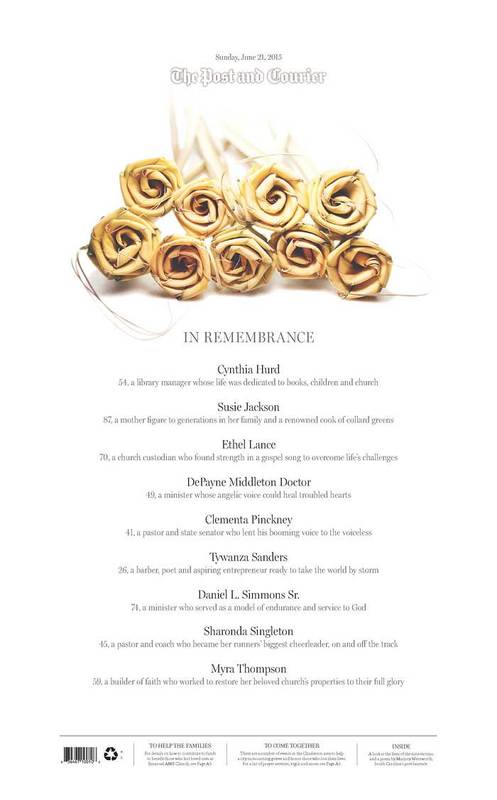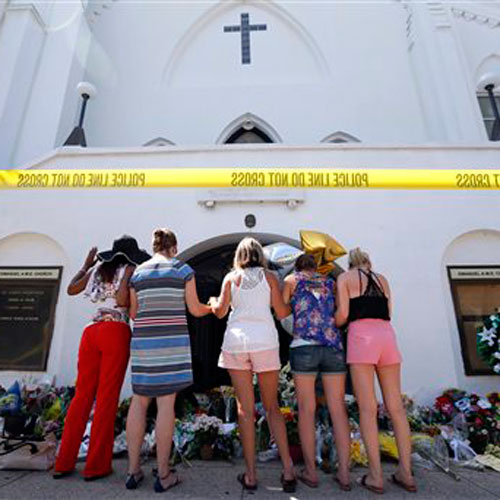It’s almost a truism of media’s digital age: For all the ways in which newspapers have been battered by the shift away from print, the front page can still play a unique and remarkable role. In times of tragedy and crisis, a well-conceived front can focus a community’s grief and seek to represent a shared response—and, in a sign of the times, become widely shared on social media in the process.
That’s what has happened over the past week in the wake of the racist massacre at a black church in Charleston, South Carolina, where The Post and Courier has produced a series of sensitive, visually powerful front pages that emphasize mourning and resilience. The images have been shared by thousands of people across the internet, and drawn a grateful response from readers on Facebook.
The most impressive was the Sunday front, a spare lay-out with a picture of nine palmetto roses, sometimes called sweetgrass roses, along with the names and a few details about each of the victims.

The design promptly drew appreciation from national observers. But in South Carolina, those aren’t just any flowers.
“We had talked about using flowers or candles,” Mitch Pugh, the Post and Courier’s executive editor, told me. “The palmetto rose, it’s a little thing that is very much quintessential Charleston, and downtown Charleston, where the church is.”
He credited Chad Dunbar, the paper’s design desk chief, with coming up with the sweetgrass roses. Often sold by street vendors, the roses are a sort of modern tourist-economy variation on sweetgrass baskets, which have a rich and well documented history in South Carolina. Slaves brought the technique used to make the baskets from Africa, and for generations, black residents of the state’s Low Country sold the baskets in roadside stands outside of Charleston. The baskets, originally made of bulrushes, are now a combination of sweetgrass, palmetto, and pine straw. Today, it’s not uncommon to see the baskets and roses for sale alongside each other in downtown Charleston.
The rose front was actually part of a wrap cover; inside, the paper ran remembrances of each of the victims. And it devoted the back page to a poem the editors asked South Carolina’s poet laureate, Marjory Wentworth, to compose about the shooting.
“She has written about racial issues before,” Pugh explained. “She agreed and within a day, she had written a pitch-perfect poem.”
The Post and Courier started planning the Sunday front a couple days in advance, though the decision was made early on not to run shooter Dylann Storm Roof’s picture on the front. “We knew the church was probably going to hold a service,” Pugh said. “We didn’t want to have the suspect’s face out there on the day of the service.”
Roof’s image isn’t on the second Sunday cover, either, where the lead story is about the planned church service. In fact, The Post and Courier has yet to run a picture of the suspect on the front page. That’s a conscious decision, Pugh said, and one that has come in for praise–as has the paper’s broader coverage of the story. “We felt, in our community, people didn’t want to see this guy’s face in every news rack as they walked down the street,” he said.
The Sunday cover isn’t the only notable one. Since an initial misstep that involved a gun range sticker ad atop the first news account in print—for which Pugh promptly apologized–the covers have served to memorialize the victims, capture pain and outrage, and encompass the broader Charleston community in the response to the church attack. The Friday front featured pictures of all nine victims with the headline: “The unspeakable happened in our city.” Saturday’s lead headline—carried by one of the marchers at a Unity Chain Charleston event—was “Hate won’t win.” Monday’s, like the others drawn from a quote within the story, was “Bent but not broken.” Today, the front page features Gov. Nikki Haley’s call to remove the Confederate flag from the grounds of the state capitol, and a banner editorial calling for the flag to be removed. (As The Huffington Post’s Michael Calderone notes, the paper has also launched a real-time interactive tally of where every state legislator stands on the issue.)
The emphasis on paying tribute and representing emotional solidarity is likely one reason the cover images have been received so enthusiastically on social media. An image of Sunday’s sweetgrass rose cover was shared more than 1,400 times from The Post and Courier’s Facebook page; a single tweet of the image was retweeted more than 1,000 times. The inside Sunday spread, a simple layout with stories about each of the victims, was shared even more widely. Hundreds of people commented on the Sunday layout approvingly, with notes like this one:
Tia Leanne Jones Those sweetgrass roses, so perfect. I got a little choked up as soon as I realized what they were. Good job ya’ll, now that I’ve seen it I can’t think of a better tribute.
Pugh told me his newsroom has keenly felt the need to cover this tragedy appropriately for the residents of Charleston. “I really respect what the national media does,” he said. “They come in and may have sources we don’t, with the FBI for example. But what we do is different. I think people here are tired of the 24-hour news cycle.”
Obviously, the print covers are just one element of the coverage. And as the days wear on and the national media goes home, the paper will need other ways to express and explain the news, especially as Charleston settles into the long process of trying the shooter. But in these first few days, The Post and Courier did an admirable job of reflecting its readers’ pain in stark, visually compelling—and yes, dignified—ways.
Susannah Nesmith is CJR’s correspondent for Florida, Georgia, and Alabama. She is a freelance writer based in Miami with more than 25 years working for regional and national outlets. Follow her on Twitter @susannahnesmith.

